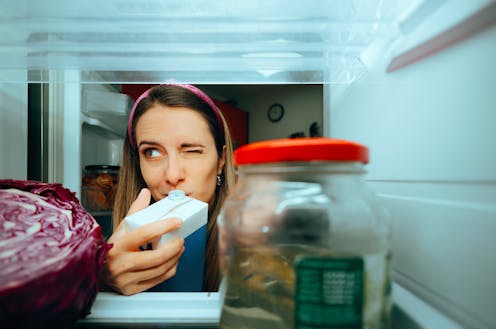Detta inlägg post publicerades ursprungligen på denna sida this site ;
Date:
Author: Oleksii Omelchenko, Doctoral Researcher in listeria and other invasive pathogens, Quadram Institute
Original article: https://theconversation.com/your-fridge-might-be-a-breeding-ground-for-bacteria-heres-how-to-fix-it-252339

The kitchen is often the heart of the home – a place where families gather and meals begin. And at the start of it all? The fridge. This is where we safely store much of our food, and as technology advances, fridges are getting smarter: being able to track inventory, suggest recipes, even displaying the news.
But of all their features, temperature remains the most critical. We rely on fridges to keep food fresh, but if the temperature isn’t right, they can do the opposite – essentially becoming cosy incubators for bacteria.
As a microbiologist, I might find that fascinating, but it’s definitely not ideal for the sausages you brought home from the farmer’s market.
When looking across many households, the average temperature in fridges is 5.3°C – just above the recommended safe range of 0–5°C (32–41°F). More concerning is how often temperatures fluctuate. Many fridges spend over half their time above that safe limit.
Some have even been found running as high as 15°C (59°F), which, in parts of the UK, is practically a warm summer’s day. At those temperatures, bacteria can multiply quickly, increasing the risk of food spoilage or even food-borne illness.
Get your news from actual experts, straight to your inbox. Sign up to our daily newsletter to receive all The Conversation UK’s latest coverage of news and research, from politics and business to the arts and sciences. Join The Conversation for free today.
So, what’s going wrong? Part of the problem is that many fridges lack an accurate, accessible way to monitor their internal temperature. Let’s admit: most of us don’t know what the dial settings actually mean.
On top of that, every time you open the door, warm air rushes in. The longer the door stays open, especially if you’re lingering while choosing a snack, the more the internal temperature climbs toward room temperature, creating a more suitable environment for bacteria to thrive.
Keep bacteria in check
Here are simple ways to keep your food fresher – and safer:
• Minimise door openings. Don’t leave the fridge hanging open while you unload groceries.
• Use a rotating organiser. A lazy susan can help you avoid searching through a shelf full of products for that half-used sauce bottle.
• Clean your door seals. Every few months, check for mould or grime and make sure the seals close tightly.
Temperature also varies inside your fridge. The coldest spot is usually at the back, while the warmest is on the door. That means items like milk or raw meat are best stored near the back – not in the door. The door is fine for butter or fizzy drinks.
Even though many modern fridges have a built-in sensor, it often only reflects the temperature at one spot. In fact, 68% of households never adjust their temperature settings.
A practical tip? Place a few stick-on thermometers in different areas of your fridge. If any are regularly above 5°C (41°F), it’s time to adjust. But remember: the built-in indicators inside your fridge don’t always reflect the actual temperature throughout your fridge.
Also, avoid overcrowding. Aim to keep your fridge about 75% full, so cold air can circulate properly. You can make room by storing items such as stone fruits, tomatoes, peppers, potatoes and honey in a cool, dry cupboard – these don’t need refrigeration.
But temperature isn’t the only concern. Even a well-chilled fridge can harbour invisible risks. Studies show that fridges can contain pathogens, likely to have been introduced previously via food or packaging that may have been contaminated.
While cold temperatures stops many bacteria from growing, some – like Listeria monocytogenes – can survive and even multiply in low temperatures. Listeria, which is especially dangerous for pregnant people and older adults, can be found in soft cheeses, cured or smoked fish (including sushi), deli meats, pre-packaged fruit, frozen veg and ready-made sandwiches.
Reduce risk
To reduce risk for yourself and others, follow recommendations from the food safety authorities:
• Keep raw foods – like meat and fish that need cooking – separate from ready-to-eat items such as fruits or sandwiches.
• Store raw meat and fish on the bottom shelf of the fridge. That way, if any juices leak, they won’t drip onto other foods.
• Consume ready-to-eat products within four hours of removing them from the fridge.
• Wash your hands regularly with soap and water before, during and after meal preparation.
• Follow the cooking instructions on packaging when applicable.
Improving your fridge habits might not sound thrilling, but it helps food stay fresher longer, keeps your fridge working more efficiently, and most importantly, protects your health – and the health of your family.
Oh, and about that leftover chicken from dinner early in the week… We’ve all done the sniff test. But just because your leftovers smell fine doesn’t mean they are fine. Bacteria like Salmonella or Listeria don’t always come with a funky odour.
Read more:
The sniff test is not reliable for food safety – here’s why
![]()
Oleksii Omelchenko receives funding from BBSRC, FSA.
Judith Evans has received funding from the European Commission, EPSRC, NGOs and development agencies.